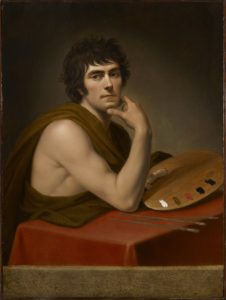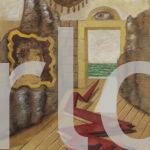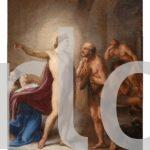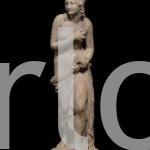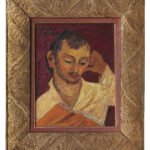| NOT AVAILABLE
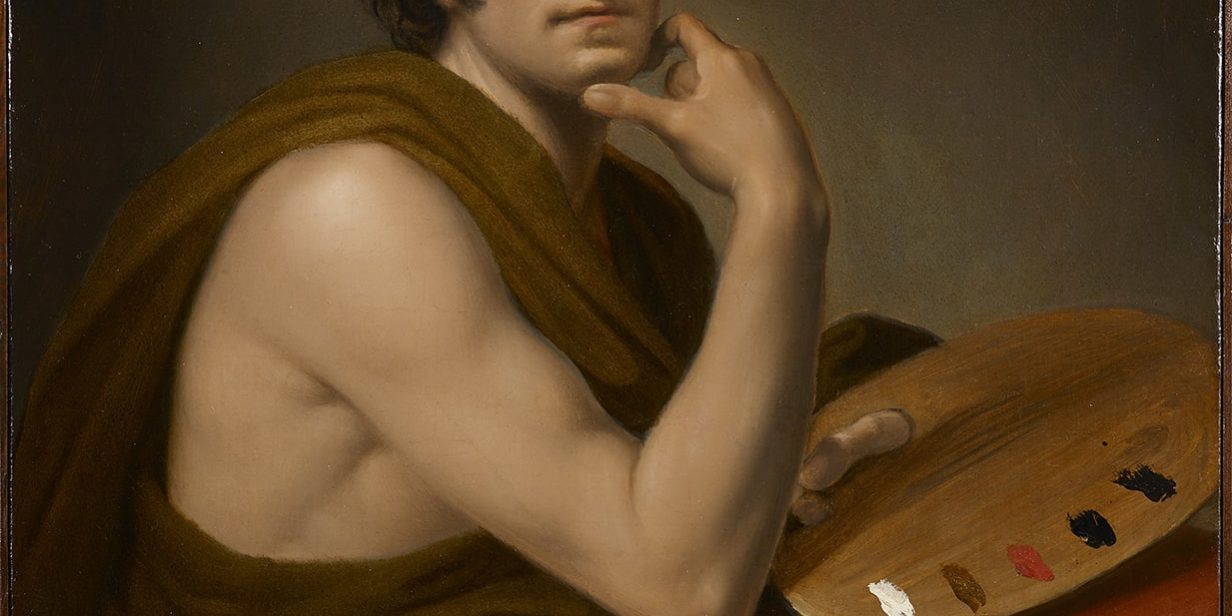
Giuseppe Errante
Trapani 1760-Rome 1821
Self-portrait
1790 ca.
Oil on canvas, 93 x 69 cm
On the typewritten cartouche glued on the back of the canvas: “AUTORITRATTO ERRANTE GIUSEPPE / da Trapani, nato nel 1760, morto nel 1821 a Roma / amico del Bossi a Milano ove dimorò. / Dipinse a fresco a Civitavecchia la cupola del- / la chiesa della morte: a Roma collocò nel 1784 / nella Chiesa di S. Vincenzo e Anastasio un suo / quadro fatto all’età di 24 anni. Nella pinacoteca / Fardelliana a Trapani vi sono suoi dipinti. Fu / seppellito a Roma in S. Salvatore in onda, ma il / suo monumento è a Trapani, eretto dalla moglie. / Dei molti suoi quadri scrisse l’Abate Canollieri. / Egli lasciò due opuscoli sui colori e valse pur / come Maestro di scherma (Dal Dizionario dei Pittori Italiani compilato da Antonietta Maria Bessonei Aurrely. Stima L. 6.000. Flli. Porta 1926.”.
The work of Giuseppe Errante, a Sicilian painter who was a leading figure in Neoclassicism in Rome, Milan and Naples, has been mostly lost, above all the most significant works mentioned by the sources and described with particular amplitude in what remains as the most important for the reconstruction of his biography and production, the Memorie raccolte da Francesco Cancellieri intorno alla vita ed alle opere del Pittore Cavaliere Giuseppe Errante di Trapani defunto in Roma a’ XVI di febbraio nell’ anno MDCCCXXI, Roma, presso Francesco Bourliè, 1824. But also see the obituary published in 1821 in “Effemeridi letterarie di Roma” (Effemeridi) and the recent monograph by S. Valenti, Giuseppe Errante pittore trapanese, Trapani 2011 (which lists the nucleus of works held by the Museo Pepoli of Trapani). While the entry, to which the cartouche refers, appears in the Dizionario dei pittori italiani published in Citta di Castello by Antonietta Maria Bessone Aurelj in 1915, of which there were later editions, in 1926 and 1928.
After his brilliant debut in Rome, where he frescoed the ceiling of the Sala Pompeiana in Palazzo Altieri with The Marriage of Cupid and Psyche, and his frecoes of the Souls in Purgatory in the church of Santa Maria della Morte in Civitavecchia, and his work for Ferdinando IV of Naples, for whom he made the painting Leda with Jupiter Disguised as a Swan, Errante moved to Milan, fleeing from Caserta where he had been accused of plotting against the king.
The period in Milan was the most brilliant of his career, not least because of the special relationship with Giuseppe Bossi and the importance of the works produced, such as the large painting (lost) inspired by the Greek legend The Beauty Contest done for Giovanni Battista Sommariva, the greatest collector of the period, or the paintings on mythological and allegorical subjects presented at the Esposizione organized in Brera in 1805 for the crowning of Napoleon as King of Italy. The most admired was Count Ugolino and his Sons in the Tower, now of unknown whereabouts but known through an engraving, which anticipated the Romantic taste proposing the famous Dantean theme. Worth remembering among the allegorical paintings celebrating Napoleon is that done for Sommariva in 1801, Napoleon as Hercules Pacifiere (Allegory of the Cisalpina Republic, now in the Musée National des Chateaux de Malmaison et Bois-Préau (Napoleone e la Repubblica italiana, pp. 112, 169-170).
With his move in 1810 to Naples, where Gioacchino Murat had called him to direct the Accademia di Belle Arti and where he remained for ten years, his activity as painter waned.
As for his portaits, many of them documented by Cancellieri, who praised their “most expressive likeness”, they, too, are lost, a fact that makes significant the finding of this very fine Selfportrait, all the rarer since we know again from Cancellieri that he was a very reserved man, uneasy with praise and self-celebration, to the point of declaring “I always felt repugnance at doing my Portrait”. His capacities as a portrait painter are confirmed by such a masterpiece in the genre, within the ambit of Italian Neoclassicism, as the extraordinary Portrait of the Noble Francesca Ghirardi Lechi with her daughter Carolina of 1800-1801 (Modena, Antonia Tonci Rizzi collection), which immortalizes one of the beauties of the period, a woman admired by the young Stendhal and depicted also by Appiani (Napoleone e la Repubblica italiana, pp. 135, 185). That painting is characterized by a soft grace and sensuality suggestive of Correggio, who was a model for Errante, and by the same warm golden light that we find in the Selfportrait.
Given the youthfulness that the painter shows this painting must date to the end of the 1780s, thus close on his early successes in Rome and Naples. The set of the image, determined not least by the choice of depicting himself in classical garb and not contemporary clothing, has something heroic about it. The artist seems proud of his looks and his youth, while showing a body shaped also by the practice of fencing at which we know he was a master.
The features recall those, certainly idealised, with which Errante appears in the bust inserted into the Monument, commissioned by his widow from the Sicilian sculptor Leonardo Pennino, realized in 1831 for the church, now cathedral, of San Lorenzo in Trapani, where it is still to be found. He is shown there, in a solution that recalls Canova’s celebrated steles, under the mantle of a female figure in classical garb, Gratitude, who gazes at his bust in tears and with her right hand crowns him with the laurels of glory.
Fernando Mazzocca
Bibliography:
Effemeridi
Effemeridi letterarie di Roma, 1821, vol. III, pp. 442-452
Valenti
S. Valenti, Giuseppe Errante pittore trapanese, Trapani 2011
Napoleone e la Repubblica Italiana 1802-1805
Napoleone e la Repubblica Italiana 1802-1805, exhibition catalogue edited by C. Capra, F. Della Peruta, F. Mazzocca, Milano 2000.
The Carlo Virgilio & C. Gallery searches for works by Errante Giuseppe (1760-1820)
To buy or sell works by Errante Giuseppe (1760-1820) or to request free estimates and evaluations
mail info@carlovirgilio.co.uk
whatsapp +39 3382427650
